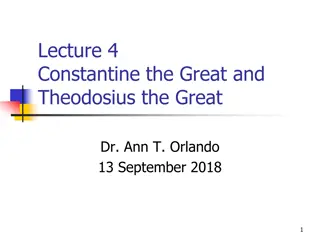Overview of the Mughal Empire and Its Great Mughals
The Mughal Empire was a significant imperial power in the Indian subcontinent from 1526 to 1757, ruled by Muslim descendants of Genghis Khan. The empire extended over a vast region and produced six great Mughal rulers: Babur, Humayun, Akbar, Jahangir, Shah Jahan, and Aurangzeb. Babur was the founder, Humayun faced challenges but reclaimed his empire, and Akbar, known for his conquests and innovative governance, was considered the greatest Mughal emperor. The empire's history showcases a blend of cultural richness and political prowess.
Download Presentation

Please find below an Image/Link to download the presentation.
The content on the website is provided AS IS for your information and personal use only. It may not be sold, licensed, or shared on other websites without obtaining consent from the author.If you encounter any issues during the download, it is possible that the publisher has removed the file from their server.
You are allowed to download the files provided on this website for personal or commercial use, subject to the condition that they are used lawfully. All files are the property of their respective owners.
The content on the website is provided AS IS for your information and personal use only. It may not be sold, licensed, or shared on other websites without obtaining consent from the author.
E N D
Presentation Transcript
WHAT WAS MUGHAL EMPIRE? THE MUGHAL EMPIRE was an imperial power in the Indian subcontinentfrom about 1526 to 1757 (though it lingered for another century). The Mughal emperors were Muslims and direct descendants of Genghis Khan throughChagatai Khan and Timur. At the height of their power in the late 17th and early 18th centuries, they controlled most of the subcontinent extending from Bengal in the east to Balochistanin the west ,Kashmir in the north to the Kaveri basin in the south.
THE GREAT MUGHALS THE LATER MUGHALS The great mughals were rulers of mughal empire till Aurangzeb. After him came the later mughals. There are six great mughals.
THE GREAT MUGHALS Babur 1483 - 1526 - 1530 (47) Humayun 1508 - 1530 - 1540 - 1556 (48) Akbar 1542 - 1556 - 1605 (63) Jahangir 1569 - 1605 - 1627 (58) Shah Jahan 1592 - 1627 - 1658 - 1666 (74) Aurangzeb 1618 - 1658 - 1707 (89)
BABUR The first of the Great Mughals was Babur ("The Tiger"), who invaded and conquered India in 1526. He was also a diarist, an enthusiastic hunter and lover of gardens. He died in the Ram Bagh gardens in Agra, and his tomb lies in gardens bearing his name in Kabul, Afghanistan. Babur was the great great- great grandson of theMongol Warlord Tamerlane.
HUMAYUN Born in Kabul, Humayun was the eldest of Babur's sons, and Born in Kabul, Humayun was the eldest of Babur's sons, and had helped his father with the conquest of India. had helped his father with the conquest of India. He ascended the throne at Agra on December 30 1530 at the age ascended the throne at Agra on December 30 1530 at the age of 23, but did not have the skills to manage the immature of 23, but did not have the skills to manage the immature empire, Afghan warlords empire, Afghan warlords In 1540 he lost his empire to Afghan leader In 1540 he lost his empire to Afghan leader Sher he hung in and managed to get it back 16 years later in he hung in and managed to get it back 16 years later in 1556. 1556. However, only six months later he died as a result of However, only six months later he died as a result of falling down the steps of his library. falling down the steps of his library. Had he known all of this at the time, he might not have chosen a name which this at the time, he might not have chosen a name which meant "the fortunate meant "the fortunate". He Sher Shah, but Shah, but Had he known all of
AKBAR The greatest of the Mughal Emperors, Akbar, The greatest of the Mughal Emperors, Akbar, was born in exile and ascended the throne at the age of 13 after his father's short and ascended the throne at the age of 13 after his father's short restoration. restoration. was born in exile In many ways Akbar was the Indian equivalent of In many ways Akbar was the Indian equivalent ofSuleiman the Magnificent (1494 Magnificent (1494 - - 1520 1520 - - 1566) 1566).. He conquered massive new territories including much of Rajasthan, created a long lasting territories including much of Rajasthan, created a long lasting civil and military administrative system (called Mansabdari), civil and military administrative system (called Mansabdari), introduced standard weights and measures, tax structures and a introduced standard weights and measures, tax structures and a workable police force. workable police force. Suleiman the He conquered massive new
Akbar was married to at least seven wives, one of them a Akbar was married to at least seven wives, one of them a Rampur Hindu princess from Jaipur. Rampur Hindu princess from Jaipur. He was enormously liberal for his time, promoting religious tolerance (and even liberal for his time, promoting religious tolerance (and even his own hybrid Islamic / Hindu / Christian / Zoroastrian his own hybrid Islamic / Hindu / Christian / Zoroastrian religion called Din religion called Din - - i llahi), abolishing slavery and i llahi), abolishing slavery and forbidding forced sati forbidding forced sati. Akbar died in Agra in 1605 and is buried in Sikandra. Akbar died in Agra in 1605 and is buried in Sikandra. He was enormously
#9.How did Mughal attitudes and policies toward Hindus change under Akbar? Akbar recognized the fundamental reality that Hindus made up a majority of the population of the Mughal Empire. He acted deliberately to accommodate the Hindu majority through actions that included allowing the Hindu princesses that he married to keep their Hindu faith. incorporating a substantial number of Hindus into the political-military elite of the empire; supporting the building of Hindu temples; imposing a policy of toleration; deliberately restraining the more militantly Islamic ulama; removing the special tax on non-Muslims promoting a state cult that drew on Islam, Hinduism, and Zoroastrianism.
JAHANGIR Jahangir was the eldest son of Mughal Emperor Jahangir was the eldest son of Mughal EmperorAkbar declared successor to his father from an early age. Impatient for declared successor to his father from an early age. Impatient for power, however, he revolted in 1599 while Akbar was engaged in power, however, he revolted in 1599 while Akbar was engaged in the theDeccan Deccan. Jahangir was defeated, but ultimately succeeded his . Jahangir was defeated, but ultimately succeeded his father as Emperor in 1605. The first year of Jahangir's reign saw father as Emperor in 1605. The first year of Jahangir's reign saw a rebellion organized by his eldest son a rebellion organized by his eldest sonKhusraw assistance of the assistance of theSikh SikhGuru Arjun Dev Guru Arjun Devand others. The rebellion was soon put down; Khusraw was brought before his father in was soon put down; Khusraw was brought before his father in chains. After subduing and executing nearly 2000 members of the chains. After subduing and executing nearly 2000 members of the rebellion, and blinding his renegade son Khusraw, Jahangir had rebellion, and blinding his renegade son Khusraw, Jahangir had Arjun Dev executed, causing a permanent deterioration of Arjun Dev executed, causing a permanent deterioration of relations between the imperium and the Sikhs relations between the imperium and the Sikhs. Akbarand was and was Khusrawwith the and others. The rebellion with the
SHAH JAHAN Shah Jahan ("Ruler of the World") inherited a near bankrupt Shah Jahan ("Ruler of the World") inherited a near bankrupt empire from his father Jahangir. empire from his father Jahangir. He turned this around, in the process becoming the best remembered of the Mughal builders, process becoming the best remembered of the Mughal builders, largely because of the largely because of theTaj Mahal Taj Mahal.. Shah Jahan initially chose to rule, like his predecessors, from the Shah Jahan initially chose to rule, like his predecessors, from the Red Fort at Agra, and it was a few miles away from here that he Red Fort at Agra, and it was a few miles away from here that he built the built theTaj Mahal Taj Mahalas a monument to his wife, known as as a monument to his wife, known as Mumtaz Mahal ("Ornament of the Palace" or "Exalted of the Mumtaz Mahal ("Ornament of the Palace" or "Exalted of the Palace" depending on the translator), who died in 1631 after the Palace" depending on the translator), who died in 1631 after the birth of their 14th child. The construction of the Taj Mahal was birth of their 14th child. The construction of the Taj Mahal was begun in 1632 and it took 20,000 laborers 17 years to complete begun in 1632 and it took 20,000 laborers 17 years to complete the job. the job. He turned this around, in the
Aurangzeb Aurangzeb was an intolerant religious (Muslim) zealot and kill-joy. He forbade music, put a stop to Mughal painting and left behind none of the architectural wonders that earlier members of his dynasty had produced. The Hindus and Sikhs fared even worse, with suppression, destruction of temples, the reintroduction of a poll tax and public executions. Just a generally nasty little man as far as most of the population were concerned, and it is not surprising that his 50 year reign was the beginning of the end for the Mughal dynasty.
Badshahi Mosque in Lahore was taken by Grandmother Paradox in 1922. The mosque, also known as The Emperor's Mosque, was built by Aurangzeb and completed in 1673.
#9.How did Mughal attitudes and policies toward Hindus change under Aurangzeb? reversed Akbar s policy of accommodation by taking actions that included: forbidding of the Hindu practice of sati banning music and dance at court, as well as banning gambling, drinking, prostitution, and narcotics; destroying some Hindu temples; Re-imposing the special tax on non-Muslims; posting censors of public morals to large cities to enforce Islamic law.























